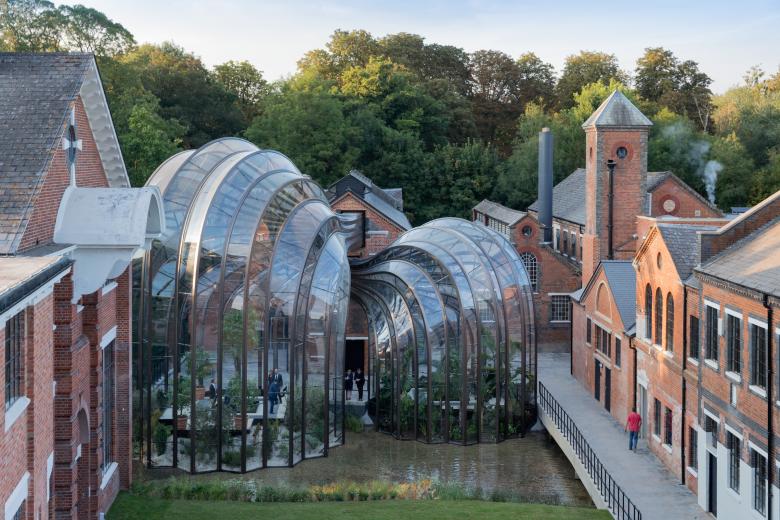'Thomas Heatherwick: Building Soulfulness' at Mori Art Museum
Kindness, Beauty and Stimulation
Heatherwick Studio: Building Soulfulness opened on March 17 at Mori Art Museum's Tokyo City View gallery. The first exhibition in Japan devoted to the UK studio of Thomas Heatherwick, Building Soulfulness displays 28 major projects over the last three decades. Ulf Meyer visited and sent us his impressions.
It is not uncommon for big real estate developers to hire famous architects as a means of stifling critiques of their large, unpopular projects. When Mori Building Co., Ltd., Tokyo’s dominant private developer, announced plans to turn Azabudai into yet another cluster of office towers, criticism was noticeable; even though, in Japan, there is a great desire for consensus and harmony, and no culture of outspoken, private opinions. Mori has jammed one tall, portly tower into the fine urban fabric of Tokyo after the other. With the latest cluster of three towers (including the tallest building in all of Japan, designed by Pelli Clarke Pelli) between Mori's existing citadels of Roppongi Hills and Toranomon Hills, the central piece of Azabudai Hills now effectively creates a wall of private towers southwest of the Imperial Palace — all owned by one company. Clearly, hiring world-class architects — first OMA/Rem Koolhaas and Christoph Ingenhoven, and, most recently, Thomas Heatherwick — was intended to make the project look desirable for the city.
Heatherwick was asked to design the Lower Levels at Azabudai Hills, a project that should bring some greenery to the base of the energy-guzzling cluster. The idea of turning downtown Tokyo into a late, commercialized version of Le Corbusier’s Ville Radieuse, with towers in a park a hundred years later, is scary. Traditionally Tokyo is neither a city of towers nor of parks; its qualities lay in the fine urban fabric of its commercial centers and residential neighborhoods.
Even though Heatherwick Studio’s design for the project is the least interesting, both in the new district as well as in the oeuvre of Heatherwick, it represented a great opportunity to present the latter in one of the tallest art museum in Tokyo: Mori Art Museum, in the Tokyo City View observation deck near the top the 54-story Roppongi Hills Mori Tower. Owned by the namesake developer, the tower is a crude mix of a bulky gray KPF-designed office tower jammed on top of a wannabe-Mediterranean shopping “landscape” designed by Jon Jerde. The pattern of large, generic office tower placed atop a low-scale, “human” retail plinth is at the core of Heatherwick’s project as well.
The views of the world’s largest city from the gallery atop the tower are stunning and include vistas of Heatherwick’s Tokyo project nearing completion. But in the case of the exhibition, Thomas Heatherwick: Building Soulfulness, there is plenty of interest when looking the other way, too. The exhibition, Heatherwick’s first in Japan, showcases 28 of his projects: from well-established earlier projects such as the UK Pavilion at the Shanghai Expo in 2010 to the brilliant Learning Hub of Nanyang University in Singapore and The Vessel in New York. Although the last had to be closed soon after its 2019 opening due to multiple suicides and stands idle to this day, this fact is not mentioned to the Japanese museum audience, of course.
Split into six chapters (“Coming Together,” “Connecting with Everyone,” “Experiencing Sculptural Space,” “Feeling Nature in Urban Space,” “Bringing Memories to the Future,” and “Playing and Using”), the show — via the PR team’s poetry — asserts that Heatherwick’s architecture “brings with it kindness, beauty, intellectual stimulation and empathy that move the human heart.” This no small claim, though maybe one size too big for some of the lesser known projects, such as the Bombay Sapphire Distillery in the former Laverstoke Mill printing plant, or the Coal Drops Yard retail district at King’s Cross, both in the UK.
Little Island, a park on a man-made pier in the Hudson River in New York is another example of Heatherwick’s ability to go from large scale to small scale and back. The transformation of the historic Grain Silo at the V&A Waterfront in Cape Town, South Afrida, into the Zeitz Museum of Contemporary Art (Zeitz MoCAA) might be one of Heatherwick’s best and most memorable creations: He turned an industrial ruin into a concrete cathedral by cutting galleries into the tubes of the old silos and grading tower. After such a bold and brave move, all he had to do was to add some cylindrical elevators and spiral staircases and let the magic atmosphere unfold.
Heatherwick was groomed into the cliché of a boy-like wizard of space: the Harry Potter of architecture. His interest in engineering is illustrated in the show through numerous study models, conceptual models, and material samples. Japanese store curtains were the inspiration behind the banners hanging from the ceiling; they make the crowded gallery feel like the inside of a Tokyo subway car where posters with advertisements dangle from the ceiling.
The sketches that illustrate how Heatherwick’s design thinking spans from industrial design to urban design are attached to the walls with visible Scotch tape — très nonchalant. Heatherwick Studio now has 200 employees working on more than thirty projects in ten countries. Azabudai Hills will not be their best. Building a “modern urban village" with a “landscape pergola” at the foot at some giant, monofunctional, fully air-conditioned, generic, supertall office towers seems ill-suited to Tokyo. But Heatherwick has ten good design ideas a minute, as his Tokyo exhibition testifies: He was allowed to design it himself (maybe he also picked its cheesy Building Soulfulness title). His latest Tokyo project is much less about “soul” and more so about putting a little bit of parsley on top of a big potato. This is a tactic that architecture should have long left behind.





